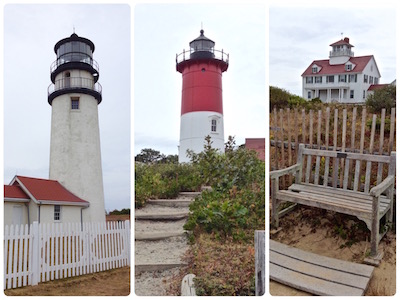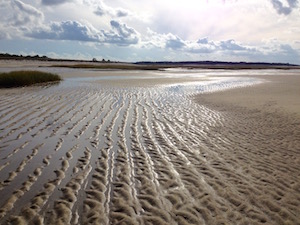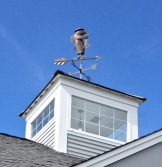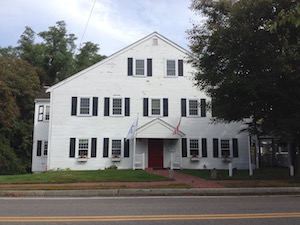 Cape Cod is lighthouses, sand dunes, boardwalks, and sand fences. It’s shellfish—take your pick: lobster, clams, or scallops—plus cranberries, ice cream cones, and coaster bikes. When you grow up in Arizona, as I did, Cape Cod seems magical. I invoked it when I painted my home a salt-sea gray and again when I planted clambering, pink roses in my gardens. But Emilie Loring finally got me to visit. She lived in Barnstable when she was in her twenties, and I had to go see.
Cape Cod is lighthouses, sand dunes, boardwalks, and sand fences. It’s shellfish—take your pick: lobster, clams, or scallops—plus cranberries, ice cream cones, and coaster bikes. When you grow up in Arizona, as I did, Cape Cod seems magical. I invoked it when I painted my home a salt-sea gray and again when I planted clambering, pink roses in my gardens. But Emilie Loring finally got me to visit. She lived in Barnstable when she was in her twenties, and I had to go see.
Travel is simple on the Cape. Highway 6 runs its full length with exits for the many villages on the Bay side and the Atlantic. I chose to stay on the Bay side. My ancestor Experience Mitchell crossed Cape Cod Bay on the Anne to land at Plymouth in 1623, a bit of genealogical history that became more real when I could see how that body of water appeared.

History is never far away on the Cape, and most places have two names to acknowledge it. I followed Highway 6A, which is also “Old King’s Highway,” and checked in at The Sea Meadow Inn, which used to be the Captain Isaiah Clark house. It was just the place—romantic rooms within walking distance of the beach, and hot, baked goods with tea in the afternoon. Ahhh, yes.
Getting in sight of water always comes first with me, so I went looking for Breakwater Beach. It’s a strange thing that the Cape is relatively narrow, but you can drive up and down Highway 6—or even coastal 6A—and capture only intermittent views. Once in a village, though, there is always a path to the water.

Breakwater Beach is a revelation. Low tide reveals a remarkable extent of rippled sand, meat-filled shells for the seagulls, and the salty, briny scent that is the Cape’s unique perfume. All the way to the open water, I wonder, “How quickly does this place refill when the tide returns?”

A short drive away is the Cape Cod Museum of Natural History, which has a small museum building and trails that lead through scraggly trees and salt marsh to a more swimmable shore on Cape Cod Bay. Small museums like this can be so-so, but this one is nice enough to bring you out to the Cape for that alone. Especially fascinating are the live, blue and calico lobsters, but there is an opportunity to learn much more about the beings that inhabit both water and shore.

Crossing to the Atlantic side and heading toward towns with cheerily Cape Coddian names like Eastham, Wellfleet, and Truro is an outdoor treasure, the Cape Cod National Seashore. Walk, picnic, or sunbathe when you go, but don’t forget your camera. In summer, the shore is dotted with people and umbrellas in bright, beach colors. In the fall, when the beach has emptied, the visit is placid, thoughtful, almost meditative.
 Barnstable was my real goal, and it, too, has two identities. Early residents engaged in farming, salt works, and whaling. By the time Emilie lived there, in the 1890s, fishing, tourism and recreation had taken over, and the Barnstable harbor welcomed yachting parties from Boston and Marblehead.
Barnstable was my real goal, and it, too, has two identities. Early residents engaged in farming, salt works, and whaling. By the time Emilie lived there, in the 1890s, fishing, tourism and recreation had taken over, and the Barnstable harbor welcomed yachting parties from Boston and Marblehead.

The old Barnstable Inn remains from Emilie’s time, as does the Sturgis Library, housed in the oldest library building in the United States. Emilie and her sister stayed at the inn, and it took no imagination at all to picture her entering the library to look for books, just as I did.
Each time Emilie published a new novel, her friend Francis Young donated a copy to the Sturgis Library. I am very sorry to say, however, that they have not been saved. There are none by her father, George M. Baker, either, but you can check out three by Emilie’s friend Sara Ware Bassett. The library specializes in New England genealogy and Cape Cod history, so Bassett’s Cape Cod novels—Eternal Deeps, An Ocean Heritage, and Son of the Sea—fit the mission.
“To Louise Gordon Hallet, whose friendship has glowed with a lovely light down through the years since we met on Cape Cod.” Dedication of Fair Tomorrow

Emilie Loring wrote only two Cape Cod novels, but they came from important memories. This is where she met Louise Gordon Hallett, to whom Fair Tomorrow is dedicated, and it is where her father died. More than a decade of research went into the discovery of the events and people that made Emilie’s time on Cape Cod significant, so you’ll have to forgive me for holding onto that information until Happy Landings’ release.
But it’s clear in Fair Tomorrow that Emilie also felt the pull–perhaps the burden–of history on the Cape. Pamela moves to her Grandmother Leigh’s Cape Cod house filled with antiques and meets Scott Mallory, who wants an “old-fashioned Thanksgiving dinner.” From Phineas Carr’s old, model-ship collection to black bands on the village chimneys, the story breathes old times on the Cape.
It’s when Pamela meets Scott for dinner in Boston that she sheds the weight of it.
The city! The adorable city! She had been starved for it.
“If a demure little Quaker had suddenly gone tap-dancer, I couldn’t be more surprised. I didn’t know you had it in you.”
And while she treasures her grandmother’s antiques, twenty-four-year-old Pamela has a different vision for herself.
“When I achieve my best-seller I will live in an apartment—I am sold on the penthouse idea—furnished in the contemporary manner—Salon des artistes décorateurs—lots of color, simple lines, sharp contrasts of dark and light. Perhaps a black mirror-top table in the dining room to repeat the gleam of silver and the sparkle of glass. A silver wall, eggshell lacquer, somewhere. –That’s my dream.”
There was one thing about olden times that Emilie would not leave behind, and it was the source of her book’s title.
“I admired your grandmother. She was a wonderful woman. Hope you have inherited her grit and her sunshiny philosophy. It was always, “Fair tomorrow’ with her. Hers was not a shallow optimism but a deep and abiding faith in the ultimate victory of the dragon-slayer.”
Cape Cod still seems magical to me, the magic of natural beauty mingling with history that is always tangible—my history, Emilie’s history, our national history. Plus lighthouses, beach roses, and lobster rolls.

I just finished “Fair Tomorrow” for the ? th time. I always like the beginning — the description of the traditional Cape Cod Thanksgiving dinner, Pamela Leigh as the cook and her brother Terence (one of my favorite characters) as the butler, and the green parrot who keeps things lively with his sayings. Then comes attorney Scott Mallory riding in like a knight to rescue Pamela from the pesky creditors. Emilie’s supporting characters are especially well-drawn in this book. You have the irascible Hitty Betts, Pamela’s father, the unlikeable Harold Leigh, poor little rich boy Philipp Carr, and Phineas “Carnation” Carr, the lawyer. When Pamela gets sued for alienation of affection by her father’s scheming wife, she hires Phineas Carr to defend the case because she feels Scott Mallory has handled enough of her legal problems. But, unbeknownst to her, Scott is helping with the case more than she knows. The court case is especially well-written, with enough nail-biting twists to keep the reader entertained. And I can’t forget “The Babe,” Scott Mallory’s German shepherd who plays an integral part in the book. “Fair Tomorrow” was written in 1931, and still retains its charm.
LikeLiked by 1 person
Some of my favorite lines come when she goes to Boston and opts for a new outfit instead of kitchen equipment. “Don’t you like me taller?”… “If a demure Quaker had suddenly gone tap dancer, I couldn’t be more surprised.” Always a favorite scene!
LikeLike
This was one of my favorites growing up. I especially liked the reference to the poem about the two frogs. Here is a link to the whole poem:
https://www.gutenberg.org/files/55341/55341-h/55341-h.htm#link2H_4_0032
LikeLiked by 1 person
Thanks for this, Carla! We can enjoy the other poems, too!
LikeLike
I did read this novel in the hardback you sent me. You are right that I did read more carefully and thoroughly with the larger font, more white in between the lines, and the wider margins. Much easier on the eyes…I wonder how much age has to do with it…and perhaps b/c I read these books at least one prior time I tend to skim over background text….
LikeLiked by 1 person
It’s a different experience, for sure. Glad you enjoyed it!
LikeLike
Reblogged this on tempehighschoolclassof1971.
LikeLike